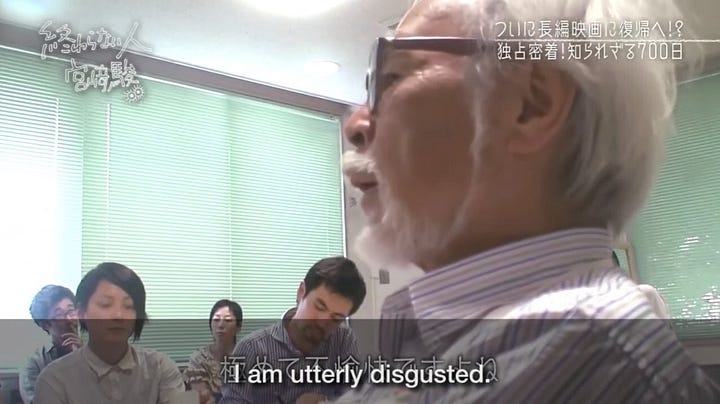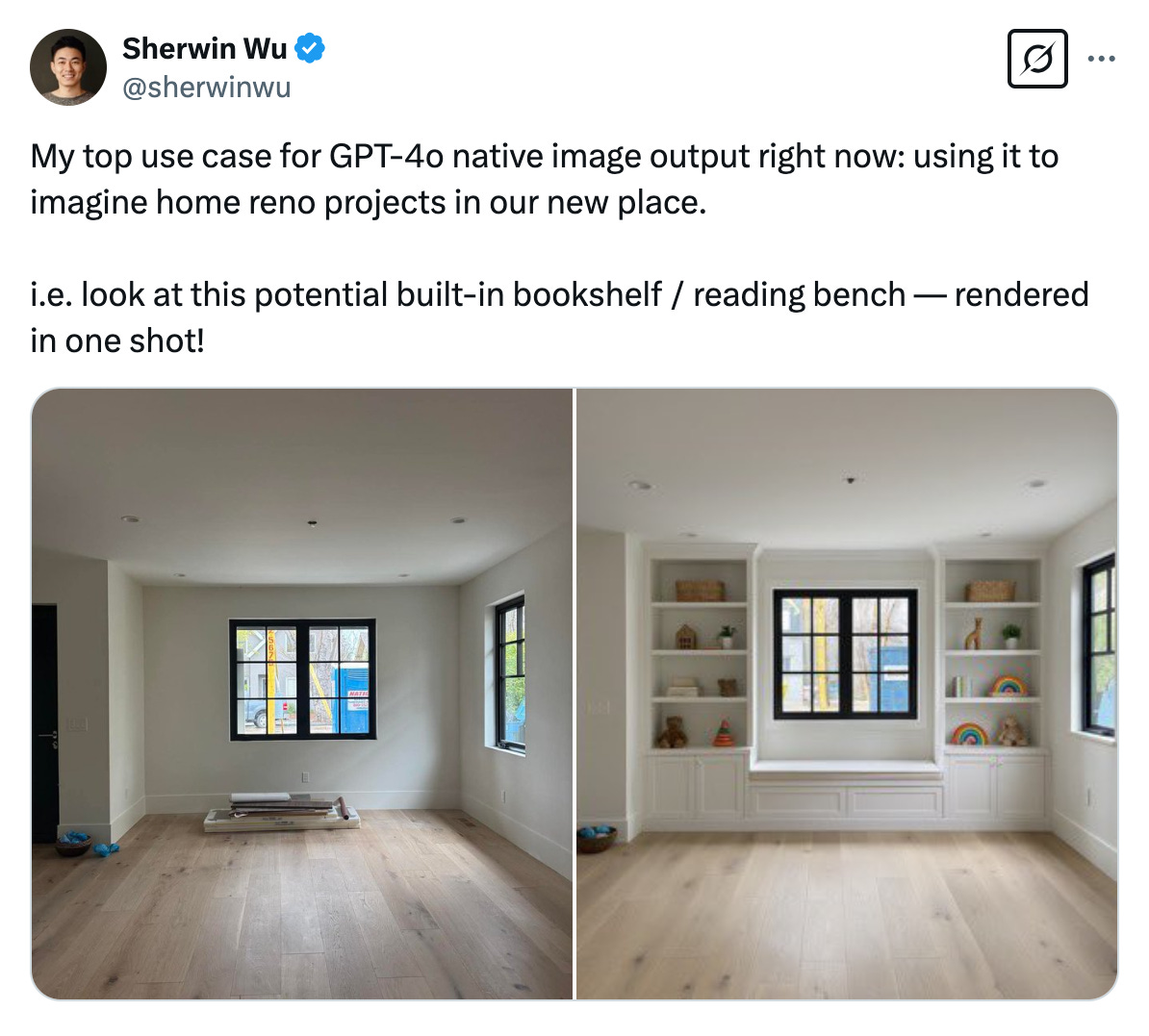OpenAI unleashed its native image generation in ChatGPT on Tuesday. By Wednesday morning, every social feed was drowning in Studio Ghibli-style portraits. (Linkedin, check back next week.) What happened—and why—is another signal of where AI, art, and our attention are headed.
How it started: Just some bros and a selfie
On March 25, OpenAI livestreamed GPT-4o’s image generation features—blending text and visuals, rendering flawless typography, and handling complex prompts with ease. At one point, the team turned a group selfie into an anime-style portrait.
Sure, the technical updates were significant: improved text rendering (a longtime challenge), better attribute binding (complex prompts, handled), and context carried across conversation. But what really matters is what we did with it.
How it’s going: Full-on Ghiblification
It started with one tweet: “Tremendous alpha right now in sending your wife photos of yall converted to studio ghibli anime,” wrote Grant Slatton. Soon everyone—even Mike Tyson—was stylizing themselves, their kids, 9/11, and memes into the soft, pastel aesthetic of Japan’s beloved animation house.


“only a few times in my life i got to see days like today when technological marvels bring together the timeline in rapturous joy,” tweeted roon. The vibes got so high, OpenAI had to delay rollout to free users.
When Grant tweeted about the trend, CEO Sam Altman replied: “Believe it or not we put a lot of thought into the initial examples we show.” (Note the Ghibli-fied avatar.)
Miyazaki vs. the machine
As billions of pixels were being Ghibli-fied, a 2016 clip resurfaced: Hayao Miyazaki, Studio Ghibli’s legendary founder, watching an AI demo. His take? “I strongly feel that this is an insult to life itself. I am utterly disgusted.”


Trung Phan called out the math: each Ghibli film contains 60–70,000 hand-drawn, watercolored frames. A four-second scene in The Wind Rises took one animator 15 months. Now, anyone summon the style in seconds.
“Imagine being Miyazaki,” tweeted Nabeel S. Qureshi, “pouring decades of heart and soul into this transcendent, tender style… and seeing it sloppified by linear algebra.”
Slop, aesthetics, and value
This tension—between delight and devaluation—sparked a broader conversation. Reggie James dubbed the trend “Ghibli slop,” not as dismissal, but as critique of what happens when distinctive artistic vision becomes infinitely reproducible at scale. “What was once valuable in the awareness of painstaking labor, beautiful stories, and coherent aesthetic,” he writes, “is now valuable PURELY in our reception to, and reproduction of, the aesthetic.”
When anyone can generate a passable Ghibli homage in seconds, the scarcity shifts—from execution to conception, from craft to taste. As
put it: “we’re exiting the scarcity economy of visuals & entering something weirder—where aesthetics become ambient infrastructure, like wifi.”Chris Paik also captured this paradox: “This commodification turns meaningful, handcrafted narratives—filled with emotional depth and human struggle—into hollow memes, diluting their artistic significance.”
The everything generator
What’s most telling isn’t just what people made, but what they didn’t. “They gave us an everything generator but everyone is obsessed with making it do the same thing,” noted Luke Miles. Given infinite possibility, we chose repetition. Ad nauseum.
Still, some interesting (dare I say useful?) applications are emerging: Sherwin Wu visualized a home renovation. Sam Dape spun up a sticker pack. Ken Wheeler personalized a kid’s book. EP made a YouTube title card.
Stealing Google’s thunder: Vibes > benchmarks
Another subplot: the hullabaloo completely eclipsed Google’s announcement of Gemini 2.5 Pro—their most advanced AI model to date—released the same day. It also came on the heels of image generation upstart Reve. As
observed: “Google dropped their biggest upgrade ever & ghibli core completely hijacked the zeitgeist. Peak example of how vibes now override tech merit in the attention economy.”The takeaway? If you’re launching a consumer product, technical superiority doesn’t automatically translate to cultural impact. In the battle for attention, a memorable vibe often beats a better benchmark.
What stays valuable
As Ghibli clones flooded the feed, “we’re cooked” tweets flew. But the flood revealed something else: when execution becomes trivial, direction becomes essential.
“This is a huge signal that design won’t disappear,” argued Joseph Alessio. “Everyone is doing ghiblicore because that’s exactly what OpenAI demonstrated. People still need someone to shape concepts—lower the floor, raise the ceiling.”
Runway’s co-founder Cristóbal Valenzuela made a bet: “If you are thinking about a new career, I would strongly suggest Art Direction. Being a good art director might end up being the most important creative role of the next decade.”
Will Manidis predicted: “The most valuable items in the future will be the old and beautiful. all of text will become ai slop, all of art will become ai slop or a reaction to ai slop. The vast majority of genuine human beauty that will exist has already been created.” As Willem Van Lancker put it in January: “Our children will romanticize and fetishize the last era of pure human creation in ways we can’t imagine.”
The policy response
By Wednesday night, OpenAI appeared to be adjusting its approach. Some users reported being blocked from generating Ghibli-style images. An spokesperson clarified that while the company prevents “generations in the style of individual living artists,” it permits “broader studio styles.” Still, they added, “We’re always learning from real-world use and feedback.”
Where do we go from here?
The Ghibli-fication of the internet made the abstract tangible. It showed us AI’s capacity to delight and its power to flatten. What comes next will depend on how we respond, not just to the tools, but to the values they surface. We’re not just generating images. We’re generating norms.
—Carly







Carly, fastest gun in the west
Great piece! AI cannot replace taste, it only amplifies. We'll see plenty of garbage made by AI, but true artists will make better work with this.
Don't agree with the full commentary on Ghibli slop -- just because something is hard to make does not mean it has artistic value, Ghibli's work are masterpieces not because they are hard to make but because of the stories and aesthetics. The scarcity of true Ghibli work is a side effect of its painstaking creative process. Using technology to cut down the time to produce a story is not slop.